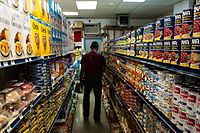
Photo from wikipedia
PURPOSE To determine if vision impairment (VI) is associated with food insecurity among the United States (US) adults. METHODS This is a cross-sectional study of US adults ≥18 years below a… Click to show full abstract
PURPOSE To determine if vision impairment (VI) is associated with food insecurity among the United States (US) adults. METHODS This is a cross-sectional study of US adults ≥18 years below a threshold of 150% poverty from the National Health Interview Survey (NHIS), years 2011-2018. Outcome measures included food insecurity status, based on response to the NHIS adult (10-item) food insecurity tool, either as a binary (food secure or insecure) or ordinal (high, marginal, low, and very low) variable. VI was defined as self-reported trouble seeing, even when wearing glasses or contact lenses. Multivariable logistic regression analyses adjusted for potential confounders examined associations between VI and food insecurity. RESULTS Participants (N = 62075) were majority female (57%), White (62%), and non-Hispanic (74%). Of them, 16% reported VI and 28% were food insecure. In fully adjusted logistic regression models, adults with VI had 216% higher odds (95% CI = 2.01-2.31) of being food insecure than adults without VI. Further, there was a dose-response relationship between VI and food insecurity noted in a multinomial model: VI predicted 159% higher risk of marginal food security (95% CI = 1.44-1.75), 197% higher risk of low food security (95% CI = 1.80-2.16), and 295% higher risk of very low food security (95% CI = 2.69-3.22), as compared to high food security. CONCLUSION VI is associated with food insecurity, increasingly so among adults with highest levels of food insecurity in this national sample of low-income US adults. This data highlights the need for targeted interventions to address and reduce the burden of food insecurity among US adults with VI.
Journal Title: Ophthalmic epidemiology
Year Published: 2022
Link to full text (if available)
Share on Social Media: Sign Up to like & get
recommendations!